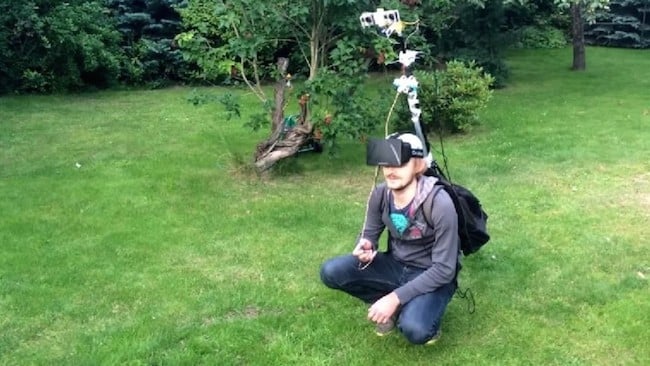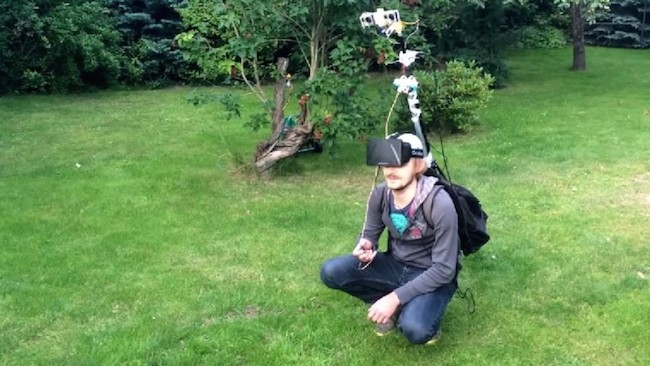

A group of Polish engineers, coders, and designers built an augmented reality rig featuring an Oculus Rift and two GoPros, and shared the demonstration / making of video. Is this backyard experiment an indicator of where augmented reality is heading?
As of the writing of this article, there are two major players in the race to popularize virtual or augmented reality, Oculus Rift and Google Glass, and neither product is yet ready for consumers. Google Glass, in beta, provides the user with augmented reality capabilities in the form of lightweight glasses; the user is never shut out from the real world, as the device is made to be worn and used while performing everyday activities. Oculus Rift, on the other hand, provides through its developer kits what we typically think of when we hear 'virtual reality,' a fully immersive experience that effectively shields the user from the real world, replacing it primarily with pre-developed game landscapes, ideal for first-person video games.
What is Facebook trying to accomplish?
When Facebook purchased Oculus Rift for $2 billion earlier this year, it left a lot of pundits scratching their heads. In the short term, the marriage of the social media giant and the maker of virtual reality headsets for gamers seemed a stretch at best. It would make more sense to develop or purchase an augmented reality product, like Google Glass, as we spend more and more time on mobile devices and away from home. Simply put, do you really want to wear something as bulky as the Oculus Rift on the subway?
When you take a long view, however, the purchase of Oculus Rift by Facebook begins to make sense. Take Google Glass as a counterpoint. It's an augmented reality platform that, due to its design, will never deliver anything that resembles the full immersion of virtual reality. But the Oculus Rift may be able to morph (and hopefully shrink) into a spectacular augmented reality device, which opens up a world of possibilities.
Real world, third person AR from Poland
A group of Polish engineers, programmers, and designers operate a Polish-language site, Mepi, as well as the English language site, Tutorial Bay, offering paid training in CAD, 3D animation, even Facebook and guitar lessons. Tinkerers by nature, the folks behind Mepi entered the Intel Make it Wearable contest, challenging makers to 'dream' or 'build' the next generation of wearable technology (as long as the 'dreams' or 'builds' utilize Intel products). The grand prize is $500,000 and a slew of other goodies, so there are definitely great rewards offered for the best innovations.
The Mepi team used the Oculus Rift as the base of its entry, but instead of developing another virtual reality application for it, the team turned the Oculus Rift into an augmented reality device by rigging two GoPros, and connecting it all with the help of an arduino and a computer with an intel processor. The resulting experience is a removed, third person perspective of actual reality, like looking down at an avatar of yourself, in the real world, in realtime. Of course, it is no avatar; it's you, as you move in space, and depending on where the camera is looking, a wider view than normal human vision. The prototype seen in the accompanying demonstration video is operated via a thumb-controlled joystick, allowing the user to change the position of the GoPro cameras.
The first modest steps toward the future of augmented reality...
The Mepi team have developed an interesting prototype, but its detractors will likely scoff at its impractical form factor and limitations. But I believe such criticisms miss the point. No, you're not going to get on a subway with this set-up either, but the idea of turning the Oculus Rift into an augmented reality device marks a radically different avenue of exploration than that of Google Glass.
The most obvious add-on to this system would be the means to track head and eye movements and translate that information into camera movements, eliminating the need for a thumb controller. But the real magic occurs when you think beyond Mepi's demonstration.
When you start to mentally tack on other emerging technology products, like the upcoming PiCam from Pelican Imaging, which is a miniature array of cameras that takes up less than the diameter of a quarter, enabling Lytros-like refocusing, 3D-model capturing, and motion data recording, then the vision of the future starts to take shape. Imagine real time augmented reality with 3D models and animation which appear, through a geared-up Oculus Rift, to occupy the same space as your living room, or the street, or Disneyland.
Pairing the imaging system with a wireless transmitter would mean you could put it on a drone in a large-scale physical game. Imagine having stereoscopic cameras on the Oculus Rift, for a POV perspective, and being able to toggle to the drone feed, to get an aerial 'map view' of the augmented experience, while interacting with real humans and CGI characters alike in the middle of an open field.
Someday, we may look back on Mepi's early experiment into augmented reality for the Oculus Rift as a watershed moment, not because of what it is, but because of what it may mean. And here's the real question: if this is what a small group of tinkerers can accomplish with very little resources, what is Facebook, with loads of cash to spend, and the Oculus Rift team working on in their research and development labs? Perhaps the most impressive innovations will come from the scores of developers out there with Oculus Rift development kits (version 2 of the Oculus SDK began shipping this week).
If the future is more social and more mobile, you better believe that Facebook is looking to solve the following puzzle: how do they get the Oculus Rift out of the gamer's den and into the real world? Hopefully, the Facebook and Oculus decision makers are paying attention, because an answer may have just presented itself in Poland.
Via PetaPixel
Tags: VR & AR


Comments